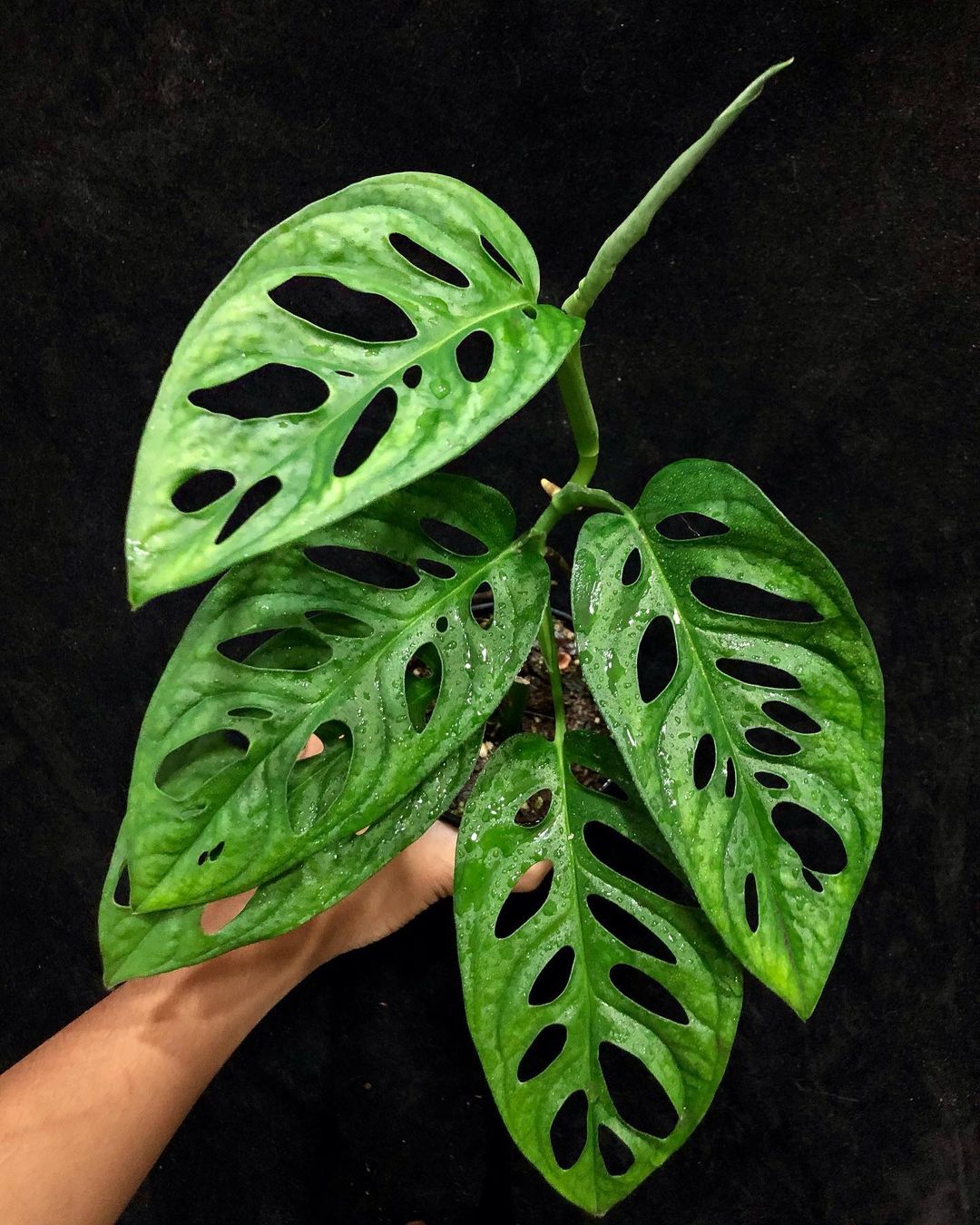Read Monstera Lechleriana Care and Growing Information to discover how to nurture this unique houseplant in our comprehensive guide.
Give a look at the Monstera Lechleriana Care and Growing Information in this post for essential tips and tricks to ensure your Monstera Lechleriana flourishes in your indoor garden.
Check Monstera Pinnatipartita Growing and Care Guide
Monstera Lechleriana Profile
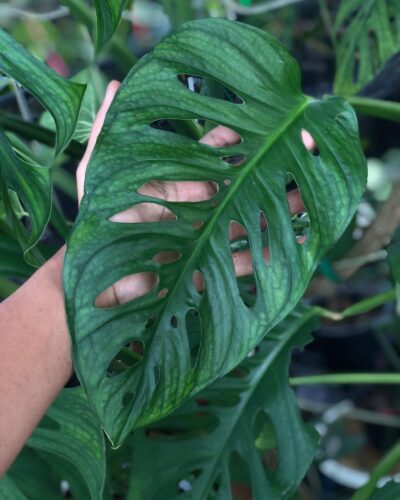
Monstera Lechleriana belongs to the Araceae family; it originates from the lush rainforests of Central and South America, including regions in Brazil, Ecuador, and Peru.
It produces large, glossy, heart-shaped leaves with deep splits or cuts. While this plant grows slowly, it can eventually reach heights of 6 to 10 feet (1.8 to 3 meters) with a compact spread of 2 to 4 feet (0.6 to 1.2 meters).
Monstera Lechleriana rarely produces inconspicuous flowers that are not a prominent feature, but its distinctive foliage makes it a popular choice for ornamental houseplant enthusiasts. For successful growth, provide moderate indirect light and regular watering when the top inch of soil dries out.
Check Philodendron Orange Marmalade Care Guide
How to Propagate Monstera Lechleriana
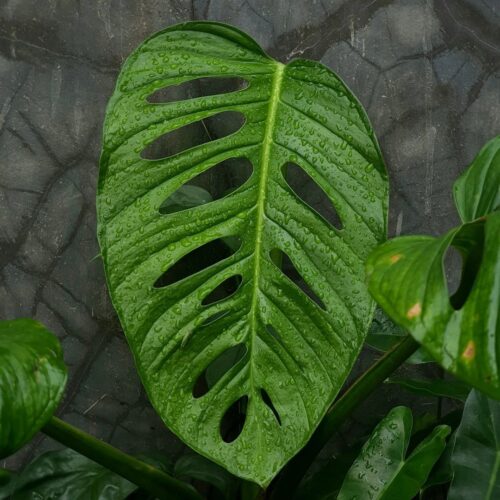
The easiest method for propagating Monstera lechleriana is through Stem Cuttings.
- Choose a healthy stem with several leaves and nodes. Nodes are the small bumps or joints on the stem where leaves and roots will develop.
- Use your pruning shears or scissors to make a clean cut just below a node. Make sure the cutting is at least a few inches long and includes at least one or two nodes.
- Allow the cut end of the stem cutting to air dry and callus over for a day or two.
- Fill a small pot with a well-draining potting mix.
- Insert the cut end of the stem into the soil, burying it about an inch or so deep. Firmly press the soil around the cutting to hold it in place.
- Cover the pot and cutting with a clear plastic bag or plastic wrap. Secure it in place with rubber bands or twine. This creates high humidity around the cutting.
- Put the potted cutting in a warm, bright location with indirect sunlight. Avoid direct sunlight, as it can scorch the cutting.
- Check the cutting regularly to ensure the soil stays lightly moist but not soggy. Mist the cutting inside the plastic bag if needed to maintain humidity.
- After a few weeks to a few months, roots should start to form.
- Once the cutting has developed a good root system, it’s ready to be transplanted into a larger pot with regular Monstera lechleriana care.
Propagating Monstera Lechleriana in Water

- Look for a healthy stem with at least one leaf and a few inches of stem below it. Ideally, choose a stem that doesn’t have any signs of disease or damage.
- Use clean pruning shears or scissors to make a clean cut just below a node. A node is a small bump or nub on the stem where leaves, roots, or branches grow.
- You can trim the cutting if it has too many leaves. Leave one or two leaves on the cutting, and remove any excess ones. This helps reduce the demand for water and nutrients during the propagation process.
- Submerge the cut end of the stem in a glass or jar of clean water. Make sure the node is completely submerged. You can use a clear container to monitor root growth easily.
- Place the container with the cutting in a location with indirect light. Avoid direct sunlight, as it can heat the water and damage the cutting. Room temperature is generally ideal.
- Change the water every 1-2 weeks to prevent the growth of algae or mold. Rinse the container thoroughly and refill it with clean, room-temperature water.
- Be patient; it can take several weeks to several months for roots to grow. You will see white, thread-like roots emerging from the node.
- Once the roots are a few inches long (typically at least 2-3 inches), you can transplant your Monstera Lechleriana cutting into a pot with a well-draining potting mix. Make a hole in the soil, gently place the rooted cutting, and pat the soil around it.
Pot Size for Growing Monstera Lechleriana
For Monstera lechleriana, an ideal pot size is 8 to 10 inches in diameter. Choose a pot made of a breathable material like terracotta or ceramic to promote proper moisture control. Ensure the pot has drainage holes at the bottom to prevent waterlogging, promoting a healthy root system.
Ideal Growing Conditions for Monstera Lechleriana
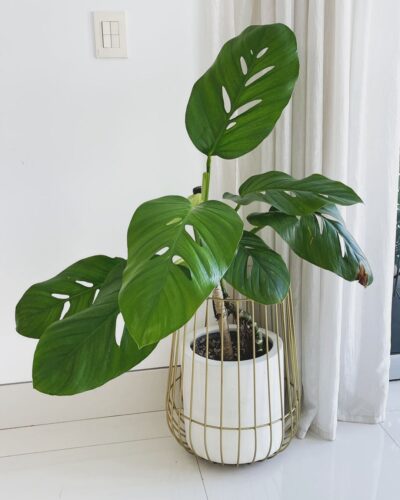
Light / Location
Monstera lechleriana thrives in bright, indirect sunlight. Place it near a north or east-facing window for optimal light exposure. Avoid direct sunlight to prevent leaf scorch. Maintain a consistent location to avoid stress. Rotate occasionally to ensure even growth and maintain its vibrant appearance.
Soil
It prefers well-draining soil. Use a mix of potting soil and perlite or orchid bark in a 2:1 ratio. This blend ensures good drainage while retaining some moisture. Aim for a slightly acidic to neutral pH range of 6.1 to 7.5.
Water
Water your Monstera when the top inch of soil feels dry. Check the soil mixture by inserting a finger in to it. Water thoroughly until it drains from the pot’s bottom. Empty the saucer beneath to prevent root rot. Typically, water every 1-2 weeks, but adjust based on your home’s humidity and season.
Temperature and Humidity
This Monstera prefers a warm environment with temperatures between 65 to 80°F (18°C to 27°C). Maintain a humidity level of 50% or higher, especially during the growing season. You can increase humidity by misting the plant, using a humidifier, or placing it on a tray filled with water and pebbles.
READ Tips to Grow Dischidia Geri in the Pots
Monstera Lechleriana Care
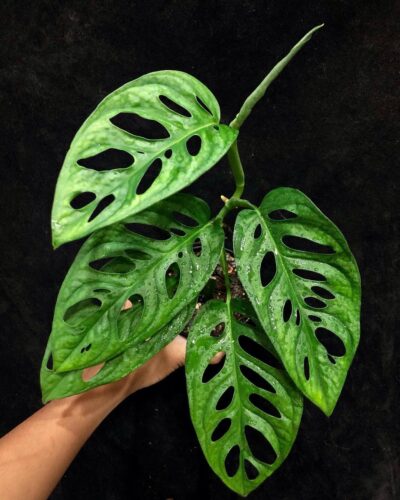
Fertilizer
Feed the plant monthly during the growing season (spring and summer) using a balanced liquid fertilizer with an NPK ratio of 20-20-20 or 10-10-10. In dormancy (fall and winter), reduce feeding to every 6-8 weeks. Important: Dilute fertilizer to half strength to prevent over-fertilization and burn.
Pruning
Prune Monstera to control size and shape, remove dead or yellowing leaves, and encourage bushier growth. Use clean, sharp shears. Trim just above a node or where a leaf meets the stem. Prune in spring or early summer when the plant is actively growing to promote recovery.
Repotting
Repotting Monstera is important every 2-3 years to ensure its well-being. Choose a slightly larger pot with good drainage, and carefully inspect and trim the roots if needed. Use a well-draining potting mix, position the plant at the same depth as before, and water thoroughly after repotting. Prune if necessary and provide support for climbing varieties. Allow the plant time to adjust and resume regular care.
Pests and Diseases
Pests:
- Mealybugs: These small, white, cottony insects can cluster on the undersides of leaves. Remove them with a cotton swab dipped in rubbing alcohol, or use neem oil as a natural pesticide.
- Spider Mites: These tiny pests can create fine webbing on your plant and cause stippling on leaves. Spray the plant with water to remove them, and use neem oil or insecticidal soap to control an infestation.
- Scale Insects: These insects often appear as small, round, or oval bumps on stems and leaves. Scrape them off with a soft brush or cloth, and then apply neem oil.
Diseases:
- Root Rot: Overwatering or poor drainage can lead to root rot. Trim away affected roots and repot the plant in fresh, well-draining soil. Adjust your watering habits to prevent future issues.
- Leaf Spot: Fungal infections can cause dark, irregular spots on leaves. Remove affected leaves and improve air circulation around the plant. Avoid overhead watering.
- Yellowing Leaves: Yellowing leaves can be a sign of various issues, including overwatering, nutrient deficiencies, or poor lighting. Diagnose the specific problem and adjust care accordingly.
Monstera Lechleriana Toxicity
Monstera lechleriana is toxic to pets and humans due to calcium oxalate crystals in its leaves and stems. Skin contact may irritate, while ingestion can lead to oral discomfort and digestive issues. To prevent problems, keep the plant out of reach of children and pets, and seek medical attention if ingestion occurs.
READ Tips for Growing Strawberry Shake Philodendron
Monstera Lechleriana vs. Adansonii

